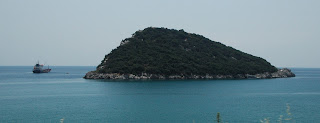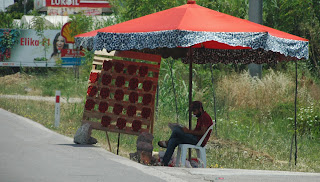It was hard leaving our beach campsite under the gum tree in Finike, but we needed to move on. We started driving along the road we had traversed twice before. We took a wrong turning in Kumluca, but this took us along an avenue of beautiful jacaranda trees — everything has its bright side! A little way past where we had camped two nights ago, we dropped into a little restaurant on the side of the road for a cuppa.
Duly refreshed, we continued on towards Antalya. On the way we passed more huge roadworks, we noted a young family out for a ride on their motorscooter (not the first 3-up on a bike we've seen, we must add), travelled through magnificent mountain scenery — and a couple of tunnels.
Nearing Antalya, we were again driving by the sea. There were little harbours and marinas along the way, and then as we approached the city, we came upon a long, very accessible and obviously very popular, beach area. While we were stopped, a vendor came past with a tray of simit — ring-shaped bread covered with sesame seeds. Suzie just had to sample one! (Not to say that Warren missed out!)
We passed through Antalya — nothing much to report about the part of the city we saw, except that it's BIG! After Antalya, we passed numerous fruit stalls by the side of the road. We were then travelling westward towards Taşağıl, or ancient Aspendos. This town was famous in antiquity for its theatre, which has been almost fully restored, and is in use to this day.
It is claimed Aspendos was founded by the people of Argos during the Greek migrations to the area in the 1200s BC. There is a lot of archaeology dating from this period to the third century AD, including a large acropolis area, but this is all in a very ruined state.
So the theatre was basically the only thing we wanted to visit here.
So the theatre was basically the only thing we wanted to visit here.
As we said, the theatre has been considerably restored, but in a sympathetic way, and the restorations are all easily identifiable by different texture and appearance. From what we see, the restoration only accounts for about 20% of the structure, so this must have been in magnificent condition to start off with.
First of all, the seating area. There are two separate sections, one above the other, each of 20 rows of seating, with a walkway separating the two. And above all the seating, an arcaded area covering another walkway.
The skena (stage area) is virtually intact, except that the colonnade in front of it has all but disappeared. Behind the facade there is a 'backstage' are rising the full height of the skena, and this has supports for flooring about halfway up. This may have been open to the sky in ancient times, but today has a modern translucent perspex roof to protect it from the elements. This solid stone stage area would have acted as a magnificent acoustic reflector, and the performances would have (and today do) take place in front of it on temporary wooden (or, today, steel) performance areas, set up in the orchestra (the semicircular open area between the skena and the seating).
All in all, a fascinating and educational experience for us — although some of the visitors spent their whole time taking 'selfies'!
As a last point, what you usually see and think of with ancient theatres is the layout of the seating area. Here we see a fully functional theatre, and the way it looks from the outside is not that much different from a modern theatre!
We enjoyed our time at Aspendos, then set off towards our next stop, Konya, in the Central Anatolian Plateau.
Have we told you that Turkish traffic has a mind of its own. For a starter, they use their horns at the drop of a hat, whether it is to say 'I'm coming through, so get out of my way!', or to make the point that you aren't already moving the instant the traffic light changes to green, or simply to say 'Hello', or (we suspect) to wake up the people in the campervan near the side of the road. But the one thing that really shook us up was the frequency of meeting a vehicle coming up the wrong way on a divided highway — usually because it is the shortest path to get to the petrol station, or the turnoff that you want. Let's not mention that the divided highways have fairly regular roundabouts in the median strip to allow you to make U-turns quite easily — maybe not quite as frequent as the roundabouts in Spain which allow the same thing, but certainly enough.
Anyway, we made our way up some quite steep slopes — we did mention that our destination is in a plateau region, about 11,000 metres above seal level. As we were making another switchback climb up a mountainside, we noticed a nice flat area, well off the road, shaded by pines, with a magnificent view of the valley below and the road we had just travelled. What better spot to stop for the night?
Distance driven — today, 144 miles ( 232 km ); to date, 21,449 miles ( 34,519 km )




































Lotsa bitsa things here. Some of the places reminded me of our Adelaide Hills are, though of course they are mountainous not just hilly. Another theatre? Well done this one. Sea, roads, traffic, markets and ruins, and of course huge bread rings. What more could one want? Are the strawberries nice? You have a thing about getting under trees. Iguess you are cool there anywqay. In storms not a good idea. but the pines look good and solid. take care, Love ya, CJ
ReplyDelete